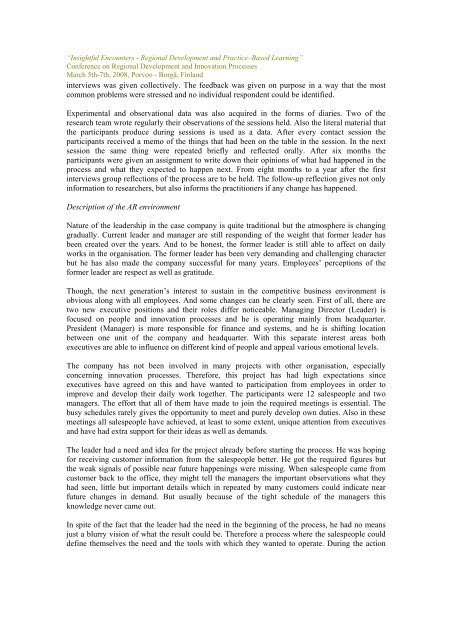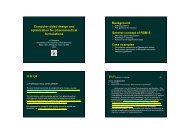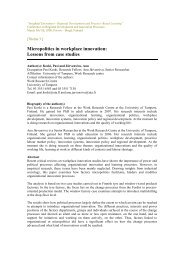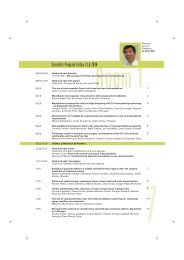Enhancing employees' innovation activity through motivational factors
Enhancing employees' innovation activity through motivational factors
Enhancing employees' innovation activity through motivational factors
You also want an ePaper? Increase the reach of your titles
YUMPU automatically turns print PDFs into web optimized ePapers that Google loves.
“Insightful Encounters - Regional Development and Practice–Based Learning”<br />
Conference on Regional Development and Innovation Processes<br />
March 5th-7th, 2008, Porvoo - Borgå, Finland<br />
interviews was given collectively. The feedback was given on purpose in a way that the most<br />
common problems were stressed and no individual respondent could be identified.<br />
Experimental and observational data was also acquired in the forms of diaries. Two of the<br />
research team wrote regularly their observations of the sessions held. Also the literal material that<br />
the participants produce during sessions is used as a data. After every contact session the<br />
participants received a memo of the things that had been on the table in the session. In the next<br />
session the same thing were repeated briefly and reflected orally. After six months the<br />
participants were given an assignment to write down their opinions of what had happened in the<br />
process and what they expected to happen next. From eight months to a year after the first<br />
interviews group reflections of the process are to be held. The follow-up reflection gives not only<br />
information to researchers, but also informs the practitioners if any change has happened.<br />
Description of the AR environment<br />
Nature of the leadership in the case company is quite traditional but the atmosphere is changing<br />
gradually. Current leader and manager are still responding of the weight that former leader has<br />
been created over the years. And to be honest, the former leader is still able to affect on daily<br />
works in the organisation. The former leader has been very demanding and challenging character<br />
but he has also made the company successful for many years. Employees’ perceptions of the<br />
former leader are respect as well as gratitude.<br />
Though, the next generation’s interest to sustain in the competitive business environment is<br />
obvious along with all employees. And some changes can be clearly seen. First of all, there are<br />
two new executive positions and their roles differ noticeable. Managing Director (Leader) is<br />
focused on people and <strong>innovation</strong> processes and he is operating mainly from headquarter.<br />
President (Manager) is more responsible for finance and systems, and he is shifting location<br />
between one unit of the company and headquarter. With this separate interest areas both<br />
executives are able to influence on different kind of people and appeal various emotional levels.<br />
The company has not been involved in many projects with other organisation, especially<br />
concerning <strong>innovation</strong> processes. Therefore, this project has had high expectations since<br />
executives have agreed on this and have wanted to participation from employees in order to<br />
improve and develop their daily work together. The participants were 12 salespeople and two<br />
managers. The effort that all of them have made to join the required meetings is essential. The<br />
busy schedules rarely gives the opportunity to meet and purely develop own duties. Also in these<br />
meetings all salespeople have achieved, at least to some extent, unique attention from executives<br />
and have had extra support for their ideas as well as demands.<br />
The leader had a need and idea for the project already before starting the process. He was hoping<br />
for receiving customer information from the salespeople better. He got the required figures but<br />
the weak signals of possible near future happenings were missing. When salespeople came from<br />
customer back to the office, they might tell the managers the important observations what they<br />
had seen, little but important details which in repeated by many customers could indicate near<br />
future changes in demand. But usually because of the tight schedule of the managers this<br />
knowledge never came out.<br />
In spite of the fact that the leader had the need in the beginning of the process, he had no means<br />
just a blurry vision of what the result could be. Therefore a process where the salespeople could<br />
define themselves the need and the tools with which they wanted to operate. During the action








